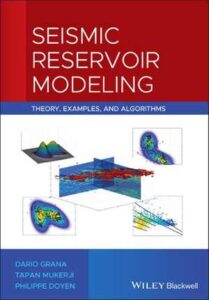نام کتاب: Seismic Reservoir Modeling – Theory, Examples, And Algorithms
نویسنده: Dario Grana و Tapan Mukerji و Philippe Doyen
ویرایش: ۱
سال انتشار: ۲۰۲۱
کد ISBN کتاب: ۱۱۱۹۰۸۶۱۸۳, ۹۷۸۱۱۱۹۰۸۶۱۸۵,
فرمت: PDF
تعداد صفحه: ۲۷۲
حجم کتاب: ۳۹ مگابایت
کیفیت کتاب: OCR
انتشارات: Wiley-Blackwell
Description About Book Seismic Reservoir Modeling – Theory, Examples, And Algorithms From Amazon
Seismic reservoir characterization aims to build 3-dimensional models of rock and fluid properties, including elastic and petrophysical variables, to describe and monitor the state of the subsurface for hydrocarbon exploration and production and for CO₂ sequestration. Rock physics modeling and seismic wave propagation theory provide a set of physical equations to predict the seismic response of subsurface rocks based on their elastic and petrophysical properties. However, the rock and fluid properties are generally unknown and surface geophysical measurements are often the only available data to constrain reservoir models far away from well control. Therefore, reservoir properties are generally estimated from geophysical data as a solution of an inverse problem, by combining rock physics and seismic models with inverse theory and geostatistical methods, in the context of the geological modeling of the subsurface. A probabilistic approach to the inverse problem provides the probability distribution of rock and fluid properties given the measured geophysical data and allows quantifying the uncertainty of the predicted results. The reservoir characterization problem includes both discrete properties, such as facies or rock types, and continuous properties, such as porosity, mineral volumes, fluid saturations, seismic velocities and density.
Seismic Reservoir Modeling: Theory, Examples and Algorithms presents the main concepts and methods of seismic reservoir characterization. The book presents an overview of rock physics models that link the petrophysical properties to the elastic properties in porous rocks and a review of the most common geostatistical methods to interpolate and simulate multiple realizations of subsurface properties conditioned on a limited number of direct and indirect measurements based on spatial correlation models. The core of the book focuses on Bayesian inverse methods for the prediction of elastic petrophysical properties from seismic data using analytical and numerical statistical methods. The authors present basic and advanced methodologies of the current state of the art in seismic reservoir characterization and illustrate them through expository examples as well as real data applications to hydrocarbon reservoirs and CO₂ sequestration studies.
درباره کتاب Seismic Reservoir Modeling – Theory, Examples, And Algorithms ترجمه شده از گوگل
هدف تعیین مشخصات مخزن لرزه ای ساخت مدل های سه بعدی از خواص سنگ و سیال، از جمله متغیرهای الاستیک و پتروفیزیکی، برای توصیف و نظارت بر وضعیت زیرسطحی برای اکتشاف و تولید هیدروکربن و برای ترسیب CO2 است. مدلسازی فیزیک سنگ و تئوری انتشار امواج لرزهای مجموعهای از معادلات فیزیکی را برای پیشبینی پاسخ لرزهای سنگهای زیرسطحی بر اساس خواص کشسانی و پتروفیزیکی آنها ارائه میکند. با این حال، خواص سنگ و سیال به طور کلی ناشناخته هستند و اندازهگیریهای ژئوفیزیک سطح اغلب تنها دادههای موجود برای محدود کردن مدلهای مخزن دور از کنترل چاه هستند. بنابراین، خواص مخزن به طور کلی از داده های ژئوفیزیک به عنوان راه حل یک مسئله معکوس، با ترکیب فیزیک سنگ و مدل های لرزه ای با نظریه معکوس و روش های زمین آماری، در زمینه مدل سازی زمین شناسی زیرسطحی برآورد می شود. یک رویکرد احتمالی به مسئله معکوس، توزیع احتمال خواص سنگ و سیال را با توجه به دادههای ژئوفیزیک اندازهگیری شده فراهم میکند و امکان کمی کردن عدم قطعیت نتایج پیشبینیشده را فراهم میکند. مسئله توصیف مخزن شامل ویژگیهای گسسته، مانند رخساره یا انواع سنگ، و ویژگیهای پیوسته، مانند تخلخل، حجم مواد معدنی، اشباع سیال، سرعتهای لرزهای و چگالی است.
مدلسازی مخزن لرزهای: نظریه، مثالها و الگوریتمها مفاهیم و روشهای اصلی شناسایی مخزن لرزهای را ارائه میکند. این کتاب مروری بر مدلهای فیزیک سنگ ارائه میکند که ویژگیهای پتروفیزیکی را به خواص الاستیک در سنگهای متخلخل مرتبط میکند و مروری بر رایجترین روشهای زمینآماری برای درونیابی و شبیهسازی چندگانه ویژگیهای زیرسطحی مشروط بر تعداد محدودی از اندازهگیریهای مستقیم و غیرمستقیم بر اساس بر روی مدل های همبستگی فضایی هسته اصلی کتاب بر روشهای معکوس بیزی برای پیشبینی خواص پتروفیزیکی الاستیک از دادههای لرزهای با استفاده از روشهای آماری تحلیلی و عددی تمرکز دارد. نویسندهروشهای اساسی و پیشرفته از وضعیت فعلی هنر در توصیف مخزن لرزهای را ارائه میکنند و آنها را از طریق مثالهای نمایشی و همچنین کاربردهای داده واقعی برای مخازن هیدروکربنی و مطالعات ترسیب CO2 نشان میدهند.
[box type=”info”]![]() جهت دسترسی به توضیحات این کتاب در Amazon اینجا کلیک کنید.
جهت دسترسی به توضیحات این کتاب در Amazon اینجا کلیک کنید.![]() در صورت خراب بودن لینک کتاب، در قسمت نظرات همین مطلب گزارش دهید.
در صورت خراب بودن لینک کتاب، در قسمت نظرات همین مطلب گزارش دهید.

